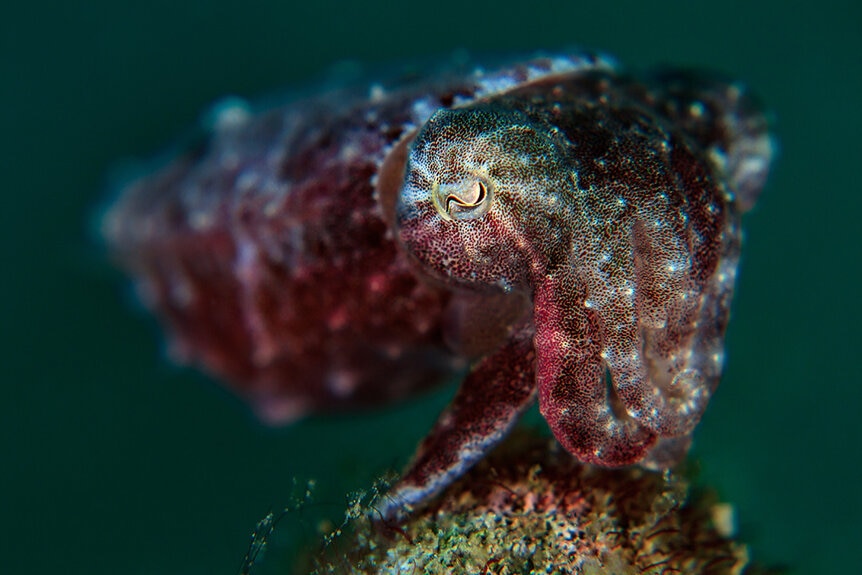Create a free profile to get unlimited access to exclusive videos, sweepstakes, and more!
Scientists Map Cuttlefish Brains Hoping to Understand Complex Camouflage
Swim around the mind of a cuttlefish with this interactive map.

When Ruby Gillman dives into the ocean for the first time, she’s (and everyone around her) is shocked by her immediate transformation into a hulking tentacled monster. Growing up is tough no matter who you are, but that’s especially true when you’re the secret heir to a watery throne as a direct descendant of cephalopod royalty. Find out if Ruby can juggle high school and achieve her destiny in Ruby Gillman, Teenage Kraken, in theaters now!
Considering the incredible camouflage of real-world cephalopods, it’s not all that surprising that one might be walking among us, a kraken in disguise. Over the last three years, a research team at Columbia’s Zuckerman Institute studied the minds of cuttlefish to create the world’s first cuttlefish brain atlas and, hopefully, figure out what makes them the masters of disguise. The results were published in the journal Current Biology.
Tracking Cuttlefish Camouflage in the Brain
In less than a second, the cuttlefish can customize both the color and the texture of its skin to blend into a dynamic range of backgrounds, even creating patterns they wouldn’t ordinarily encounter in nature. Researchers knew that camouflage in cuttlefish was a response to visual stimuli, but they weren’t clear on how information taken in by the eyes made its way to the skin.
RELATED: The Cthulhu-Esque Cuttlefish Might Actually Be a Lot Smarter Than We Ever Thought
First, the cuttlefish has to take in its environment visually. Then it has to translate the visual arena into a neural representation inside the brain. Finally, it has to recreate that visual arena on its own skin, and it has to do all of this continually in real time. It’s a complex process which hinges on the brain’s ability to translate and retranslate visual input.
Figuring out how cuttlefish do that requires understanding of how their brains process information. And understanding that could help us understand the ways our own brains process and represent information.
“We hope and believe that our brain atlas will help the community learn more about the mechanisms cuttlefish use to express themselves through their skin, and that this may give us insight into how any brain is capable of representing information,” said Dr. Tessa Montague, first author of the paper, in a statement.
Making an Interactive Cuttlefish Brain Map
The team included experts in neuroscience, tissue imaging, programming, anatomy, and web design. First, researchers scanned the bodies and brains of eight cuttlefish, four male and four female, using MRI scans. Next, an algorithm helped to identify brain tissue from surrounding tissue. Cuttlefish don’t have bones — save for the cuttlebone, an internal structure used for buoyancy — so there’s no skull barrier to clearly designate what’s brain and what isn’t.
Using the MRI scans and some historical brain images, researchers identified each of the cuttlefish’s 32 lobes. With the overarching architecture laid out, researchers wanted to get cellular definition, which required cutting the brains into incredibly thin slices, staining them, and meticulously laying out the brain organization one layer at a time.
RELATED: Cephalopods’ invisibility powers could someday be ours, now that we know how to control them
With all eight data sets completed, they merged them into one complete brain atlas. While the research has inherent value in what we’ve learned so far, it is also intended as a resource for other scientists and for the public. With that in mind, the team had to translate their data into something which might be easily consumable to anyone who wants to use it.
“The main purpose of the paper is to report the visualization and research tool, Cuttlebase, and to make it all freely available and easily accessible to everyone,” said Dr. Montague.
The project’s website includes a robust suite of cuttlefish research tools, including full 3D scans of the entire cuttlefish anatomy, a specialized model of just the brain, the cuttlefish genome, as well as diagrams and breakdowns of cuttlefish mating and reproduction. Click around the site long enough and you can make yourself something of a cuttlefish expert. And that is exactly what researchers are hoping for.
No cephalopod education is complete without Ruby Gillman, Teenage Kraken. Get your tickets now!



























